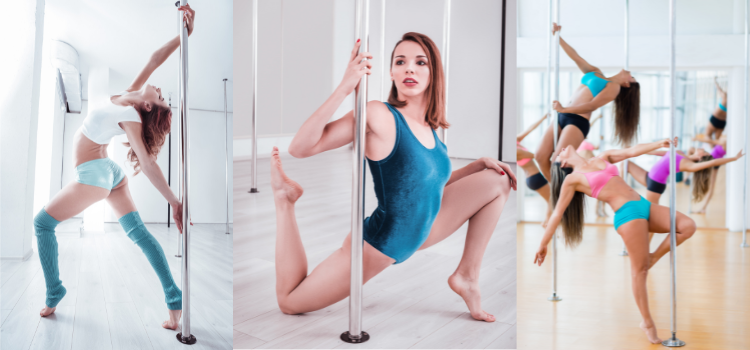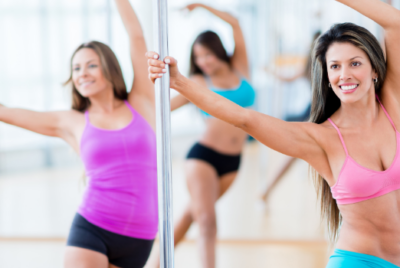5 best Pole Dance Beginner Moves and Where to Move After
Pole dancing has gained popularity not only as an entertaining and artistic form of dance but also as a challenging and rewarding fitness activity. If you’re a beginner eager to dip your toes into the world of pole dance, you’re in the right place. In this article, I’ll guide you through some of the essential pole dance beginner moves that will set the foundation for your pole dancing journey.
Benefits of Pole Dance for Beginners
Before we dive into the moves, let’s explore why pole dance is a fantastic choice for beginners. Apart from the fun and self-expression it offers, pole dancing provides numerous physical and mental benefits that can transform your fitness journey.
Building Strength and Flexibility: Pole dance requires a great deal of upper body and core strength, making it an excellent full-body workout. As a beginner, you’ll gradually develop strength in your arms, shoulders, and back through basic moves like spins and holds. Additionally, the stretching involved in pole dance routines enhances flexibility, allowing you to improve your range of motion over time.
Improving Confidence and Body Awareness: Pole dancing encourages self-expression and body positivity. By learning new moves and conquering challenges, you’ll gain a sense of accomplishment, boosting your self-confidence. Moreover, as you become more attuned to your body’s movements and positioning on the pole, your overall body awareness and coordination will improve.
Boosting Cardiovascular Health: While pole dance primarily focuses on strength and flexibility, it also provides cardiovascular benefits. Engaging in continuous movement during routines elevates your heart rate, improving cardiovascular endurance over time. Pole dance is a unique combination of strength and cardio, making it a dynamic and effective form of exercise.
Safety Precautions and Warm-up Exercises
Before you begin your pole dancing practice, it’s crucial to prioritise safety and warm-up properly. Following these precautions will reduce the risk of injuries and ensure a more enjoyable experience.
Checking Equipment and Environment: Inspect the pole for any defects or damages before using it. Ensure it is securely installed and that the floor around the pole is clear of any obstructions. If you’re using a portable pole, ensure it’s stable and installed following the manufacturer’s instructions.
Stretching and Warming up Muscles: To prepare your body for the physical demands of pole dance, start with a thorough warm-up. Perform dynamic stretches that target the major muscle groups used in pole dance, such as your arms, shoulders, back, hips, and legs. Warming up increases blood flow, improves flexibility, and reduces the risk of strains or pulls.
Practicing Proper Form and Technique: When executing pole dance moves, focus on maintaining proper form and technique. This includes engaging the correct muscles, maintaining a straight posture, and avoiding excessive swinging or jerking motions. Proper technique not only ensures a graceful and controlled performance but also reduces the risk of injuries.
Basic Pole Dance Beginner Moves
Now that you’re warmed up and ready to go, let’s explore some basic pole dance moves that are perfect for beginners. Mastering these pole dance beginner moves will provide a solid foundation for your pole dance journey.
The Fireman Spin
The Fireman Spin is a fundamental move that helps beginners build confidence and get comfortable with spinning around the pole. Start by gripping the pole with both hands, stepping away from the pole, and then spinning around it while keeping your legs extended.
The Chair Spin
The Chair Spin is another beginner-friendly move that introduces you to rotational momentum. Begin by gripping the pole with one hand, extending your legs, and then using your momentum to spin around the pole while keeping your legs tucked.
The Back Hook Spin
The Back Hook Spin is a graceful move that involves hooking your leg around the pole while spinning. Start by gripping the pole with both hands, extending one leg backward, and hooking it around the pole. Use your core muscles to maintain control as you spin.
The Pole Sit
The Pole Sit is a static hold that strengthens your upper body and core. Begin by gripping the pole with both hands, lifting your feet off the ground, and resting your inner thighs against the pole. Engage your core and practice holding the position for increasing durations.
The Knee Hook
The Knee Hook is a move that requires strong upper body engagement and balance. Start by gripping the pole with one hand, lifting one leg, and hooking your knee around the pole. Gradually release your hand grip and practice balancing using your core muscles.
Progressing to Intermediate Moves
Once you feel comfortable with the basic moves, it’s time to challenge yourself and progress to intermediate pole dance moves. These moves will further enhance your strength, flexibility, and overall skills.
The Carousel Spin
The Carousel Spin involves spinning around the pole while extending your legs horizontally. Begin by gripping the pole with both hands, extending your legs, and spinning while keeping your body straight. This move requires coordination and controlled spinning.
The Gemini
The Gemini is an intermediate move that combines strength and flexibility. It involves holding onto the pole with both hands while extending one leg and hooking it around the pole. This move showcases elegance and grace.
The Ballerina Spin
The Ballerina Spin is a move that requires balance and core strength. Begin by gripping the pole with one hand, extending your legs, and spinning while keeping one leg extended horizontally. This move emulates the poise and grace of a ballerina.
The Extended Butterfly
The Extended Butterfly is a challenging move that demonstrates your upper body and core strength. Begin by gripping the pole with both hands, lifting your body off the ground, and extending your legs in a split position. This move requires stability and controlled strength.
The Ayesha
The Ayesha is an advanced move that showcases strength, flexibility, and body control. It involves gripping the pole with both hands, extending your legs, and lifting your body into a horizontal position while holding the pole with your legs. The Ayesha is a remarkable accomplishment for any pole dancer.
Tips for Successful Practice
As you embark on your pole dancing journey, keep these tips in mind to make the most of your practice sessions and ensure a successful progression.
Consistency is Key: Consistency is crucial when learning pole dance. Set aside regular practice sessions and stick to them. Consistent practice allows your muscles to adapt, improves muscle memory, and enhances your overall progress.
Listening to Your Body: Pay attention to your body’s limits and listen to any discomfort or pain signals. Pole dance can be physically demanding, so it’s essential to know when to rest, modify your movements, or seek guidance from a professional instructor.
Seeking Professional Instruction: Consider taking classes with a qualified pole dance instructor. Professional guidance ensures you learn the correct techniques, reduces the risk of injuries, and provides valuable feedback for improvement.
Cross-training and Conditioning: To excel in pole dance, incorporate cross-training and conditioning exercises into your routine. Strengthen your core, arms, and legs through exercises like weightlifting, yoga, Pilates, or callisthenics. Conditioning your body enhances your overall performance on the pole.
Setting Realistic Goals: Pole dance progress varies for each individual, so set realistic goals based on your own abilities and aspirations. Celebrate small milestones along the way, such as nailing a new move or improving your flexibility. Remember that progress takes time, dedication, and patience.
Common Mistakes to Avoid
To ensure a safe and effective pole dance practice, be aware of these common mistakes that beginners often make.
Skipping Warm-up and Cool-down: Failing to warm up properly can increase the risk of muscle strains or other injuries. Similarly, skipping the cool-down can leave your muscles tight and sore. Always allocate time for warm-up and cool-down exercises.
Using Grip Aids Excessively: While grip aids can be helpful for maintaining a good grip on the pole, relying on them excessively can hinder your progress. Gradually reduce your dependence on grip aids as you develop natural grip strength and technique.
Overexertion and Ignoring Fatigue: Pushing yourself too hard or ignoring signs of fatigue can lead to injuries. Respect your body’s limits, take breaks when needed, and gradually increase the intensity and duration of your practice sessions.
Rushing Progression: Pole dance is a journey, and rushing through the progressions can hinder your growth. Master all the pole dance beginner moves before moving on to the next level. Building a strong foundation will make your pole dance practice more enjoyable and safer in the long run.
Neglecting Safety Measures: Always prioritise safety by checking the equipment, using crash mats when necessary, and practising in a well-ventilated space. Safety should be a top priority to ensure a positive pole dancing experience.
Conclusion
Embarking on a pole dancing journey as a beginner is an exciting endeavour that offers a combination of fitness, creativity, and self-expression. By starting with pole dance beginner moves, gradually progressing to intermediate techniques, and practising with consistency and safety in mind, you can unlock the incredible benefits of pole dance. Remember to set realistic goals, listen to your body, seek professional guidance, and celebrate your achievements along the way. Happy pole dancing!
FAQs
Q1: Is pole dance suitable for beginners with no prior dance or fitness experience?
A1: Absolutely! Pole dance is suitable for beginners regardless of their previous dance or fitness experience. It’s a welcoming and inclusive form of exercise and self-expression.
Q2: Can I install a pole at home for practice?
A2: Yes, you can install a pole at home for practice. Ensure that you follow the manufacturer’s instructions for installation and choose a suitable location with adequate space and a sturdy floor.
Q3: Will pole dancing help me lose weight?
A3: Pole dancing can aid in weight loss by combining cardiovascular exercise with strength training. However, individual weight loss results may vary based on factors such as diet and overall physical activity.
Q4: Can I practise pole dance during pregnancy?
A4: It’s essential to consult with your healthcare provider before practicing pole dance during pregnancy. They can provide guidance based on your specific circumstances.
Q5: How long does it take to progress to advanced pole dance moves?
A5: The time it takes to progress to advanced pole dance moves varies for each individual. It depends on factors such as practice consistency, natural abilities, and dedication to learning and mastering the foundational moves.




